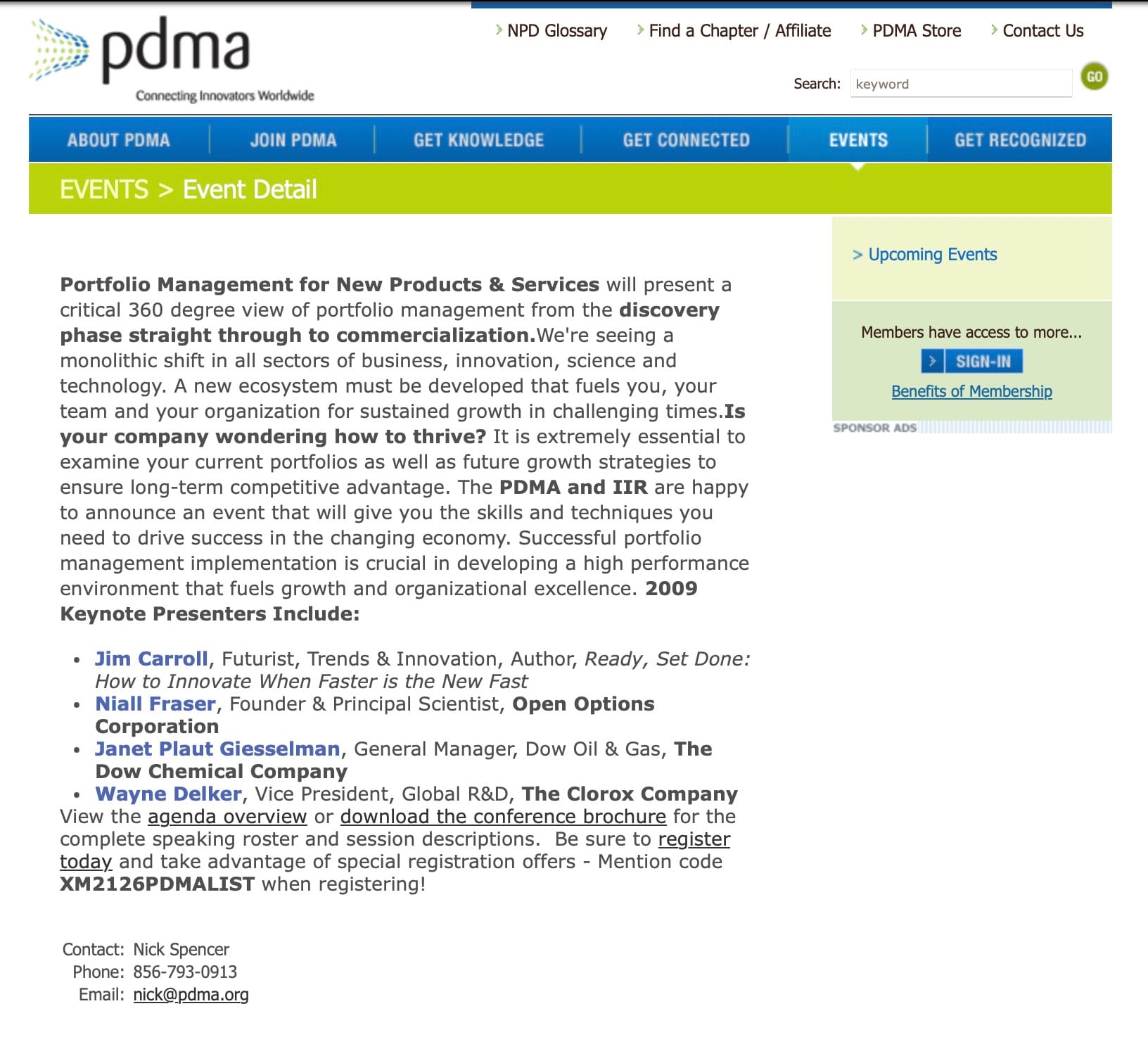Let's talk about how once great nations lose their place in the global R&D background, and as a result, lose their future!
Back in 2009, I was the opening keynote speaker for the annual PMDA conference on innovation - with a talk on the 'hollowing out of corporate R&D." As noted on their site, "The Product Development and Management Association is a global community of professional members whose skills, expertise and experience power the most recognized and respected innovative companies in the world." The association membership includes key individuals involved in R&D for the 3M's, Duponts, Dow Chemical, and other industrial powerhouses of the world.

They asked for a hard-hitting message on how the US was losing its position as the pre-eminent R&D 'factory' of the world, and I obliged. I took them on that tour, and wrote the blog post below, "The Hollowing Out of Corporate R&D." Essentially, I told the story of how the US was losing its dominance as other (mostly Asian) companies took the lead, as open source innovation took on new momentum, and small collaboration was beating 'big collaboration.'
Fast forward - we now have a nation that is turning its back on science, as it shutters entire R&D arms of government, as many begin to reject the essence of science itself, and as immigration and other policies begin to attack the individuals who undertake scientific research. This never ends well. Scientists will always pursue their work in the nations that welcome them, and which create an environment that is conducive to their slow, collaborative research.
History shows what happens when industrial or government policies decimate R&D. Canada lost a big part of its future when the Diefenbaker government shut down the most advanced fighter jet program in the world at the time, the Avro Arrow, in the late 1950s. Many of those scientists and engineers went on to work on the NASA space program, causing a big gap in the ability of Canada to play a major role in the future for decades - and one that it is still feeling to this day. That's but one example of what happens when the minds that matter move elsewhere (Right now, considering how things are going, Canada should do a 'reverse Avro Arrow' play, welcoming US scientists to relocate their future and their minds to the country!)
The minds of science develop the future - the discoveries that are made fuel the innovations that are pursued which create the products that evolve. Keep in mind my key mantra for tomorrow: "Companies that do not yet exist will build products not yet conceived using materials not yet invented with methodologies not yet in existence with ideas yet to be imagined." That context provides the factory for the future, the jobs of tomorrow, and the possibilities for companies and nations to thrive. Thrive they won't when science is rejected.
In that context, how is global R&D science changing today compared to the trends I spoke about years ago? I fed my original article (found below) to Claude.AI, asking it to reflect on the trends I identified, l and to identify the implications. Check out the response - looking back from 2025, these trends have not only continued but accelerated dramatically! China has approached U.S. research output levels, open source models have transformed multiple industries, startup innovation has flourished with venture capital growing from $50 billion to over $600 billion annually, specialized innovation brokers have become standard, and user co-creation is now mainstream practice.
The "hollowing out" of traditional corporate R&D has accelerated, creating a more globally distributed innovation landscape where the U.S. maintains strength in software and AI but has lost ground in manufacturing innovation and materials science, confirming what Claude calls my 'remarkably prescient analysis." (It's nice when an AI compliments you!)
And all this has happened before the nation decided to turn its back on science.
What's the future impact? Where the minds move, the future follows, because scientists will always find a home where they can choose to make science great again!
The Hollowing Out of Corporate R&D
February 2009, Jim Carroll
[ original post ]
I've just returned from delivering the opening keynote for the 14th Annual Portfolio Management for New Products & Services Conference in Fort Lauderdale, an event sponsored by the Product Development and Management Association.
I spoke to the broad theme of "innovating faster," but also challenged the crowd to think about how the "source of innovative ideas" has changed.
Some pretty dramatic trends have gained traction. The source of innovation is rapidly shifting from: North America to Asia. Noted corporate R&D centers such as Bell Labs, Xerox's Palo Alto, and the IBM TJ Watson Center play a far smaller role in global innovation today. On the rise? Overseas labs such as GE's John Welch Center in Bangalore. Noted
- North America to Asia. Noted corporate R&D centers such as Bell Labs, Xerox's Palo Alto, and the IBM TJ Watson Center play a far smaller role in global innovation today. On the rise? Overseas labs such as GE's John Welch Center in Bangalore. Noted Business Week in a recent article: "...we will soon witness a dramatic rise in the participation of India and China in global R&D.....the reason for this is the diminished role of corporate laboratories that were the birthplace of the ideas of the 20th century."
- corporate R&D groups to open-sourced ideas. The head of R&D for Johnson & Johnson recently observed that fast-paced scientific discovery and increasing complexity of discovery is driving this trend: "All simple diseases have been solved. The next-generation drugs, and therapies, are much more complex. You need much more information and science than what you can get out of your labs." Extend this thinking to the complexity of innovation in the energy, environmental, and healthcare sectors -- the scope of innovation is becoming too large, and an organization can't simply master all the innovation knowledge they need to in order to discover what's next. That's why increasingly, organizations need to tap into the global idea cycle for idea generation and innovation research.
- large to small. Simply put, innovation is switching from large corporations and labs to smaller, more nimble competitors. Here are some sobering numbers; big pharma's 10 biggest companies spent $50 billion on R&D last year. For that sum, they could buy the entire US biotech industry, excluding the top five companies. Yet, 3/4 of all new approved drugs approved came from small biotech labs. Big R&D is quite broken -- and perhaps even dysfunctional.
- R&D departments to R&D partner implementation conduits. When ideas flow fast, companies can't hope to master every skill set and knowledge niche. That's why increasingly, they are turning to outsiders for insight and ideas. Enter the innovation-transfer partner: an organization that links innovative thinkers to those with a need for such insight. Take Bioline Israel: "....the company operates as a clinical bridge between drug researchers and inventors, and large pharmaceutical companies interested in purchasing viable new therapies: (Jerusalem Post, January 2009.) Expect this model to flow into every other industry quickly because of the sheer complexity of fast knowledge! Do you want a business for the future? Think innovation brokering!
- hidden innovation to public innovation. In the "old days" -- say, one or two years ago -- companies used to innovate secretly, carefully, and cautiously. Increasingly, organizations are willing to put their ideas out to the public at large, to get open, honest feedback on what they are doing right and what they are doing wrong. Consider McDonald's -- its D10 store in the airport in Sydney, Australia, is being used as a public innovation space.
The audience at the conference was representative of a broad swathe of Fortune 500 companies. I think my overview might have freaked them out to a degree: but we can't deny the reality of this fast-paced shift in the source of innovation. My advice was to accept the transition and begin to shift how you think about the source of new insight and begin to adjust your corporate planning accordingly.
How has R&D Shifted Since the Original Article?
An Overview by Claude.AI, March 2025
The Geographic shift from North America to Asia continues
- This trend has accelerated significantly. China's R&D spending has grown from about 1.7% of GDP in 2010 to over 2.4% by 2022-2023.
- By 2020, China surpassed the US in the total number of published research papers, and by 2022-2023, it was approaching the US in terms of highly-cited papers.
- Major companies have expanded their Asian R&D footprints. Microsoft Research Asia, Google's AI China Center, and Apple's engineering centers in China all grew in importance.
- Beyond China, countries like South Korea became innovation powerhouses in areas like semiconductors, displays, and batteries.
Shift from corporate R&D to open-sourced ideas
- This trend has completely transformed innovation ecosystems. Open-source software now dominates many technology sectors.
- In pharmaceuticals, the trend mentioned in the article accelerated - the traditional R&D model continued to struggle with productivity, while partnerships, biotech acquisitions, and external innovation networks grew in importance.
- By 2023, over 60% of new drug approvals originated outside large pharma's internal R&D.
- COVID-19 vaccine development demonstrated how networked R&D (Pfizer-BioNTech, Oxford-AstraZeneca) outpaced traditional in-house approaches.
Shift from large to small organizations
- This hollowing out has continued as predicted. Startup innovation has dominated many sectors.
- Venture capital funding grew from about $50 billion globally in 2010 to over $600 billion by 2022, fueling small-company innovation.
- Large companies increasingly adopted "acquire, don't develop" strategies for innovation, with many tech giants spending more on acquisitions than internal R&D.
- Corporate venture capital became a standard practice, with most Fortune 500 companies establishing CVC arms by 2022.
R&D departments becoming implementation conduits
- The predicted "innovation broker" model has emerged in multiple forms.
- Universities greatly expanded technology transfer operations.
- Specialized innovation consultancies proliferated.
- Open innovation platforms like InnoCentive expanded in scope and importance.
- The pharmaceutical industry broadly adopted the "innovation scout" model, with dedicated teams seeking external innovations.
Hidden to public innovation
- This has transformed into "user co-creation" as standard practice.
- Companies routinely release beta products for public testing and feedback.
- Crowdsourcing platforms for innovative ideas have become mainstream corporate tools.
- Communities of practice have formed around products, providing ongoing feedback for iterative innovation.
The "hollowing out" has indeed continued and accelerated in most sectors. Traditional corporate R&D—especially fundamental research—has declined in relative importance. National labs and universities still conduct basic research, but the translation to commercial innovation has become more globalized and distributed.
By 2023-2024, the US innovation system remained strong in software, AI, and certain life sciences areas, but had ceded ground in manufacturing innovation, materials science, and consumer electronics. The global innovation landscape became more multipolar, with centers of excellence distributed across North America, Europe, and Asia.
The article was remarkably prescient in identifying these key shifts. The trends it highlighted in 2009-2011 have defined the innovation landscape through the subsequent 15 years.
Futurist Jim Carroll has written many remarkably prescient blog posts, with a remarkable track record of future prediction accuracy.

